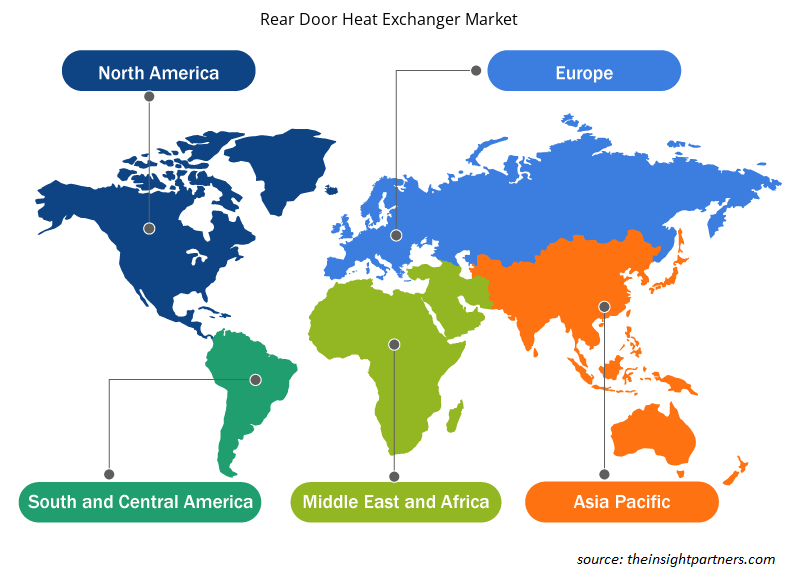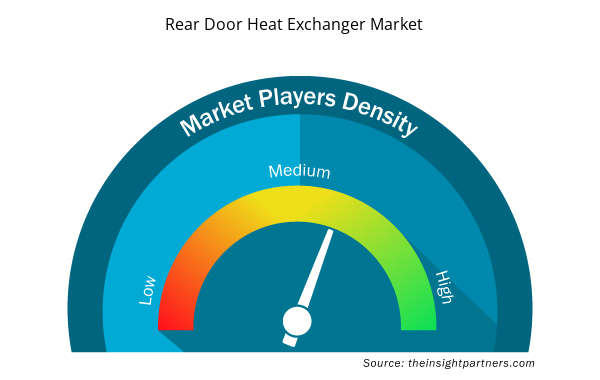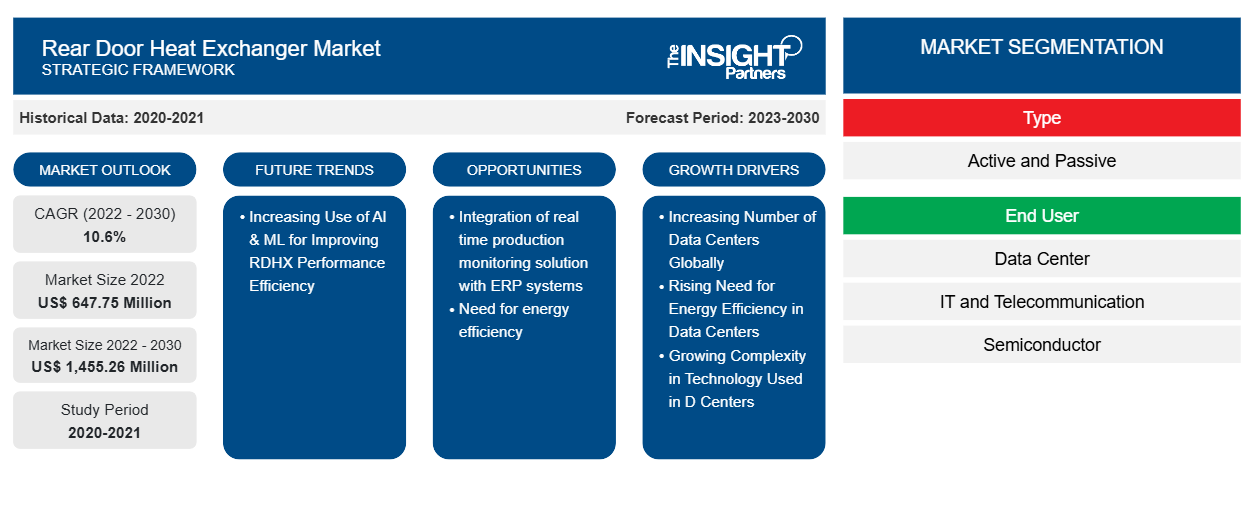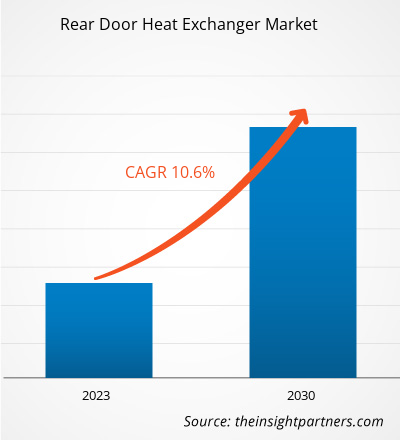[調査レポート] リアドア熱交換器市場規模は2022年に6億4,775万米ドルと評価され、2030年までに14億5,526万米ドルに達すると予想されており、2022年から2030年にかけて10.6%のCAGRを記録すると予測されています。
アナリストの視点:
リアドア熱交換器市場の製品は、主に高密度データセンターで冷却機構として使用され、医薬品や化学薬品などの他の重要な産業ではターゲット冷却に使用されます。リアドア熱交換器市場の製品は、データセンターでサーバーラックをアクティブまたはパッシブに冷却するのに効果的であることが実証されています。これらはサーバーラックのリアドアに直接取り付けられ、集中冷却システムとは独立して動作します。世界中のデータセンター数の増加と、これらのデータセンターのエネルギー効率への関心の高まりにより、リアドア熱交換器市場の成長が促進されると予想されます。
リアドア熱交換器市場の概要:
リアドア熱交換器は、2 つの流体を混合せずに熱を伝達するデバイスです。リアドア熱交換器は、データ センター、教育、政府、IT および通信など、さまざまなアプリケーションで使用されています。リアドア熱交換器には、パッシブ リアドア熱交換器とアクティブ リアドア熱交換器の 2 種類があります。リアドア熱交換器 (RDHx) は、特にデータ センターの高密度サーバー環境で使用されています。RDHx は、データ センターで使用される冷却ソリューションの一種で、サーバー ラックの背面に取り付けられた熱交換器を使用して IT 機器の排気から熱を取り除きます。冷却された空気はデータ センターに再循環されるため、従来のコンピューター ルーム空調 (CRAC) ユニットの必要性が軽減されます。RDHx は、熱負荷、気候、サーバー設計、メンテナンスなどの特定の状況下では、データ センターの空気冷却の効率的な方法になります。RDHx は、熱負荷が高く、IT 機器の密度が高い場合に最も効率的です。
リアドア熱交換器市場のメーカーは、リアドア熱交換器市場の需要に応えるためにさまざまな製品を発売しています。たとえば、2023年5月にCoolIT Systemsは、初の直接液体冷却(DLC)対応リアドア熱交換器(RDHx)を含むポートフォリオの拡張を発表しました。データセンターは2030年までに世界の電力の8%を消費すると推定されており、この課題に効果的に対処するソリューションの採用が必要です。RDHxは、直接液体冷却を使用する顧客に高度な冷却技術を提供します。さまざまなリアドア熱交換器メーカーが他の市場プレーヤーと提携して、新しいリアドア熱交換器を提供しています。
要件に合わせてレポートをカスタマイズする
このレポートの一部、国レベルの分析、Excelデータパックなど、あらゆるレポートを無料でカスタマイズできます。また、スタートアップや大学向けのお得なオファーや割引もご利用いただけます。
- このレポートの主要な市場動向を入手してください。この無料サンプルには、市場動向から見積もりや予測に至るまでのデータ分析が含まれます。
リアドア熱交換器市場の推進要因:
データセンターで使用される技術の複雑化がリアドア熱交換器市場の成長を促進
データ センターでは、科学研究、シミュレーション、データ分析などのタスクにハイ パフォーマンス コンピューティング (HPC) テクノロジが採用されています。これらのシステムは、計算負荷が高いため、かなりの熱負荷が発生します。リア ドア ヒート エクスチェンジャーは、これらの高密度環境に効率的な冷却を提供します。また、データ センターは岐路に立っています。コンピューティング、ストレージ、通信容量の需要が急速に高まっています。IT 機器は、より多くの電力を消費し、より多くの熱を生成しています。電気料金は今後数年間で上昇すると予想されています。一方、ビジネスと経済の圧力により、企業は施設を統合し、運用を合理化し、IT コストを積極的に削減することを余儀なくされています。エンクロージャーあたりの平均熱密度が増加するにつれて、データ センターを適切に運用するために必要な冷却を提供することがますます困難になっています。冷却システム内の非効率性により、提供すべき冷却が、熱負荷に厳密に必要な冷却の 2 倍になることがあります。これらのソリューションは熱密度が高くなる可能性があるため、正確な冷却が不可欠です。リア ドア ヒート エクスチェンジャーは、このようなインフラストラクチャに必要な温度を維持するのに役立ちます。このような理由から、データセンターでは冷却効率を高めるために、リアドア熱交換器の需要が高まっています。
さらに、マルチテナントおよびコロケーション データ センターでは、さまざまな顧客要件と機器構成によって、さまざまな熱プロファイルが生じる可能性があります。リア ドア熱交換器は、個々の顧客のニーズに合わせて調整できる、柔軟で局所的な冷却ソリューションを提供します。リア ドア熱交換器は、ラック レベルの冷却を提供し、モジュール式およびラックベースのデータ センター設計のトレンドと一致しています。サーバー ラックに直接設置できるため、最も必要な場所に正確な冷却を提供します。したがって、データ センターで使用されるテクノロジの複雑さが増すにつれて、リア ドア熱交換器の需要が高まり、リア ドア熱交換器市場の成長を後押ししています。
リアドア熱交換器市場のセグメント分析:
タイプに基づいて、リアドア熱交換器市場はアクティブとパッシブに分けられます。リアドア熱交換器市場の製品は、高密度データセンターのサポートに最適です。リアドア熱交換器市場のさまざまなメーカーが、データセンター冷却アプリケーション用のアクティブタイプのリアドア熱交換器を発売しています。たとえば、2019年6月、Nortek Air SolutionsはServerCoolリアドア熱交換器製品ラインを発売しました。Nortek Air Solutionsは、データセンター冷却アプリケーション用のADHX 35-6Bアクティブリアドア熱交換器を発売しました。ADHX 35-6Bは、ServerCoolの成功したADHXの次世代であり、バックドア熱交換器の冗長性、使いやすさ、耐久性、エネルギー効率の分野で改善を提供します。ADHX 35-6Bは、総所有コスト(TCO)と電力消費効率(PUE)の点で、データセンター業界の他のADHXよりも優れています。さらに、設置コストとメンテナンスコストの両方を削減する実証済みのエンジニアリング設計を提供します。この改良された設計は、冷水システムを備えた改造や新規データセンターに適しており、35kW の冷却能力に対して 500W 未満の電力を消費し、PUE 値はわずか 1.033 になります。
リアドア熱交換器市場の地域分析:
北米のリアドア熱交換器市場規模は、2022年に2億6,564万米ドルと評価され、2030年までに5億8,627万米ドルに達すると予測されています。2022年から2030年にかけて10.4%のCAGRを記録すると予想されています。北米のリアドア熱交換器市場は、米国、カナダ、メキシコに分割されています。データセンターは、北米経済の将来において重要な役割を果たしています。より多くの企業とユーザーがデジタル領域に移行するにつれて、効率的な情報処理の必要性が高まっています。データセンターは通信ネットワークコネクタであるため、ユーザーはリモートで作業していても情報に迅速にアクセスできます。米国国際貿易委員会(USITC)のレポートによると、米国のデータセンターセクターは2023年に999億7,000万米ドルの価値があると予想されています。世界中に8,000のデータセンターがあり、そのうち33%のデータセンターは米国にあります。北米のデータセンター市場の上位5つの推進要因は、デジタル化、リモートワーク、デジタルテクノロジー、AIとML、OTTサービス、IoTです。この地域では、データセンターの成長が鈍化する兆候は見られません。より多くのデジタルアクセス、ストレージ、およびデータプロセスに対する需要は常に高まっています。さらに、カナダ統計局によると、2020年5月のカナダで在宅勤務をしている中核世代の従業員の割合は約43%でした。2021年12月までに、カナダの中核世代の従業員の26%が在宅勤務をしていました。テレワーカーの90%は、オフィスでの作業と比較して、リモートワークでの生産性が一貫しているか、それ以上であると報告し、テレワーカーの41%は週の半分の時間をリモートで作業することを好みました。ハイテクに精通した社会とリモートワークのトレンドの組み合わせは、北米のデータセンター市場規模の永続的な増加を意味します。
さらに、データセンターの成長には、モノのインターネット (IoT) と AI という 2 つの理由があります。毎日インターネットに接続するデバイスが増えるにつれて、生成されるデータの量も増えています。したがって、この膨大なデータを保存するために、この地域ではより多くのデータセンターが必要です。リアドア熱交換器市場の製品は、データセンターの建物の内部から外部に熱を伝達することで、両方の気流を分離するために、データセンターで広く使用されています。したがって、北米でのデータセンターの需要の増加に伴い、リアドア熱交換器市場の製品のニーズが大幅に増加しています。
リアドア熱交換器市場の主要プレーヤー分析:
Coolcentric、Nortek Air Management、USystems Limited、COOLIT SYSTEMS、nVent Electric plc、Vertiv Group Corp、STULZ GMBH、Motivair Corporation、IBM、Airedale は、リアドア熱交換器市場で活動している主要企業です。
リアドア熱交換器市場の地域別分析
予測期間を通じてリアドア熱交換器市場に影響を与える地域的な傾向と要因は、Insight Partners のアナリストによって徹底的に説明されています。このセクションでは、北米、ヨーロッパ、アジア太平洋、中東、アフリカ、南米、中米にわたるリアドア熱交換器市場のセグメントと地理についても説明します。

- リアドア熱交換器市場の地域別データを入手
リアドア熱交換器市場レポートの範囲
| レポート属性 | 詳細 |
|---|---|
| 2022年の市場規模 | 6億4,775万米ドル |
| 2030年までの市場規模 | 14億5,526万米ドル |
| 世界のCAGR(2022年 - 2030年) | 10.6% |
| 履歴データ | 2020-2021 |
| 予測期間 | 2023-2030 |
| 対象セグメント | タイプ別
|
| 対象地域と国 | 北米
|
| 市場リーダーと主要企業プロフィール |
|
市場プレーヤーの密度:ビジネスダイナミクスへの影響を理解する
リアドア熱交換器市場は、消費者の嗜好の変化、技術の進歩、製品の利点に対する認識の高まりなどの要因により、エンドユーザーの需要が高まり、急速に成長しています。需要が高まるにつれて、企業は提供を拡大し、消費者のニーズを満たすために革新し、新たなトレンドを活用し、市場の成長をさらに促進しています。
市場プレーヤー密度とは、特定の市場または業界内で活動している企業または会社の分布を指します。これは、特定の市場スペースに、その規模または総市場価値と比較して、どれだけの競合相手 (市場プレーヤー) が存在するかを示します。
リアドア熱交換器市場で事業を展開している主要企業は次のとおりです。
- クールセントリック
- シュトゥルズ英国有限会社
- ノーテックエアソリューションズ LLC
- エヌヴェント・エレクトリック社
- インターナショナル・ビジネス・マシーンズ・コーポレーション
免責事項:上記の企業は、特定の順序でランク付けされていません。

- リアドア熱交換器市場のトップキープレーヤーの概要を入手
最近の動向:
合併や買収などの無機的および有機的な戦略は、リアドア熱交換器市場の企業によって広く採用されています。最近の主要なリアドア熱交換器市場の動向をいくつか以下に示します。
- 2019 年 1 月、Nortek Air Solutions は、ServerCool™ データ センター液体冷却製品ラインに 35kW アクティブ リア ドア熱交換器 (ADHX) である ADHX 35-6B を導入しました。ADHX 35-6B は、冗長性、使いやすさ、耐久性、エネルギー効率が向上した、ServerCool の好評の ADHX の次世代製品です。
- 2021 年 8 月、データ センター冷却ソリューションの専門メーカーである USystems Ltd と、データ センター ソリューションの設計、供給、設置のスペシャリストである Rahi Systems は、USystems ColdLogik リア ドア熱交換器 (RDHX) とイン ロー クーラーの世界的な供給と設置を実現するための提携を発表しました。
- 過去2年間の分析、基準年、CAGRによる予測(7年間)
- PEST分析とSWOT分析
- 市場規模価値/数量 - 世界、地域、国
- 業界と競争環境
- Excel データセット



Report Coverage
Revenue forecast, Company Analysis, Industry landscape, Growth factors, and Trends

Segment Covered
This text is related
to segments covered.

Regional Scope
North America, Europe, Asia Pacific, Middle East & Africa, South & Central America

Country Scope
This text is related
to country scope.
よくある質問
Increasing use of AI & ML for improving RDHx performance efficiency, which is anticipated to play a significant role in the global rear door heat exchangers market in the coming years.
Increasing number of data centers globally, rising need for energy efficiency in data centers, and growing complexity in technology used in data centers are the major factors that propel the global rear door heat exchanger market.
The global rear door heat exchangers market is expected to reach US$ 1455.26 million by 2030.
The Global rear door heat exchangers market was estimated to be US$ 647.75 million in 2022 and is expected to grow at a CAGR of 10.6% during the forecast period 2022 - 2030.
The incremental growth expected to be recorded for the global rear door heat exchangers market during the forecast period is US$ 807.52 million.
The key players holding majority shares in the global rear door heat exchangers market are Coolcentric, Stulz Uk Ltd, Nortek Air Solutions, LLC, Nvent Electric Plc, and International Business Machines Corp.
Trends and growth analysis reports related to Electronics and Semiconductor : READ MORE..
The List of companies - Rear Door Heat Exchanger Market
- Coolcentric
- Stulz Uk Ltd
- Nortek Air Solutions, LLC
- Nvent Electric Plc
- International Business Machines Corp
- Coolit Systems Inc
- Vertiv Group Corp.
- Usystems Limited
- Airedale International Air Conditioning Ltd
- Motivair Corporation
The Insight Partners performs research in 4 major stages: Data Collection & Secondary Research, Primary Research, Data Analysis and Data Triangulation & Final Review.
- Data Collection and Secondary Research:
As a market research and consulting firm operating from a decade, we have published and advised several client across the globe. First step for any study will start with an assessment of currently available data and insights from existing reports. Further, historical and current market information is collected from Investor Presentations, Annual Reports, SEC Filings, etc., and other information related to company’s performance and market positioning are gathered from Paid Databases (Factiva, Hoovers, and Reuters) and various other publications available in public domain.
Several associations trade associates, technical forums, institutes, societies and organization are accessed to gain technical as well as market related insights through their publications such as research papers, blogs and press releases related to the studies are referred to get cues about the market. Further, white papers, journals, magazines, and other news articles published in last 3 years are scrutinized and analyzed to understand the current market trends.
- Primary Research:
The primarily interview analysis comprise of data obtained from industry participants interview and answers to survey questions gathered by in-house primary team.
For primary research, interviews are conducted with industry experts/CEOs/Marketing Managers/VPs/Subject Matter Experts from both demand and supply side to get a 360-degree view of the market. The primary team conducts several interviews based on the complexity of the markets to understand the various market trends and dynamics which makes research more credible and precise.
A typical research interview fulfils the following functions:
- Provides first-hand information on the market size, market trends, growth trends, competitive landscape, and outlook
- Validates and strengthens in-house secondary research findings
- Develops the analysis team’s expertise and market understanding
Primary research involves email interactions and telephone interviews for each market, category, segment, and sub-segment across geographies. The participants who typically take part in such a process include, but are not limited to:
- Industry participants: VPs, business development managers, market intelligence managers and national sales managers
- Outside experts: Valuation experts, research analysts and key opinion leaders specializing in the electronics and semiconductor industry.
Below is the breakup of our primary respondents by company, designation, and region:

Once we receive the confirmation from primary research sources or primary respondents, we finalize the base year market estimation and forecast the data as per the macroeconomic and microeconomic factors assessed during data collection.
- Data Analysis:
Once data is validated through both secondary as well as primary respondents, we finalize the market estimations by hypothesis formulation and factor analysis at regional and country level.
- Macro-Economic Factor Analysis:
We analyse macroeconomic indicators such the gross domestic product (GDP), increase in the demand for goods and services across industries, technological advancement, regional economic growth, governmental policies, the influence of COVID-19, PEST analysis, and other aspects. This analysis aids in setting benchmarks for various nations/regions and approximating market splits. Additionally, the general trend of the aforementioned components aid in determining the market's development possibilities.
- Country Level Data:
Various factors that are especially aligned to the country are taken into account to determine the market size for a certain area and country, including the presence of vendors, such as headquarters and offices, the country's GDP, demand patterns, and industry growth. To comprehend the market dynamics for the nation, a number of growth variables, inhibitors, application areas, and current market trends are researched. The aforementioned elements aid in determining the country's overall market's growth potential.
- Company Profile:
The “Table of Contents” is formulated by listing and analyzing more than 25 - 30 companies operating in the market ecosystem across geographies. However, we profile only 10 companies as a standard practice in our syndicate reports. These 10 companies comprise leading, emerging, and regional players. Nonetheless, our analysis is not restricted to the 10 listed companies, we also analyze other companies present in the market to develop a holistic view and understand the prevailing trends. The “Company Profiles” section in the report covers key facts, business description, products & services, financial information, SWOT analysis, and key developments. The financial information presented is extracted from the annual reports and official documents of the publicly listed companies. Upon collecting the information for the sections of respective companies, we verify them via various primary sources and then compile the data in respective company profiles. The company level information helps us in deriving the base number as well as in forecasting the market size.
- Developing Base Number:
Aggregation of sales statistics (2020-2022) and macro-economic factor, and other secondary and primary research insights are utilized to arrive at base number and related market shares for 2022. The data gaps are identified in this step and relevant market data is analyzed, collected from paid primary interviews or databases. On finalizing the base year market size, forecasts are developed on the basis of macro-economic, industry and market growth factors and company level analysis.
- Data Triangulation and Final Review:
The market findings and base year market size calculations are validated from supply as well as demand side. Demand side validations are based on macro-economic factor analysis and benchmarks for respective regions and countries. In case of supply side validations, revenues of major companies are estimated (in case not available) based on industry benchmark, approximate number of employees, product portfolio, and primary interviews revenues are gathered. Further revenue from target product/service segment is assessed to avoid overshooting of market statistics. In case of heavy deviations between supply and demand side values, all thes steps are repeated to achieve synchronization.
We follow an iterative model, wherein we share our research findings with Subject Matter Experts (SME’s) and Key Opinion Leaders (KOLs) until consensus view of the market is not formulated – this model negates any drastic deviation in the opinions of experts. Only validated and universally acceptable research findings are quoted in our reports.
We have important check points that we use to validate our research findings – which we call – data triangulation, where we validate the information, we generate from secondary sources with primary interviews and then we re-validate with our internal data bases and Subject matter experts. This comprehensive model enables us to deliver high quality, reliable data in shortest possible time.


 このレポートの無料サンプルを入手する
このレポートの無料サンプルを入手する